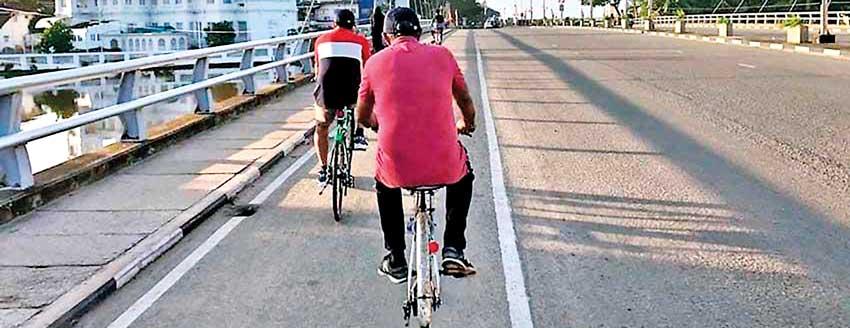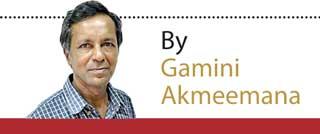09 Feb 2023 - {{hitsCtrl.values.hits}}

 It’s no wonder that our bicycle boom ended almost as abruptly as it began. People will not ride bicycles until they feel safe with improved conditions, and no one should blame them It’s no wonder that our bicycle boom ended almost as abruptly as it began. People will not ride bicycles until they feel safe with improved conditions, and no one should blame them |
 Most of all, the government has to reduce taxes on bicycles, spare parts and accessories. Bicycles have become so pricey that many people can’t afford them Most of all, the government has to reduce taxes on bicycles, spare parts and accessories. Bicycles have become so pricey that many people can’t afford them |
The government talks of promoting bicycles but has done next to nothing. There are a few allocated bicycle lanes on main roads, but those are bus lanes, too, and everyone uses them
 I remember there was a cycling boom of sorts from May to July 2021. People who had never touched a bicycle in their lives began riding. But you don’t see them anymore. What happened?
I remember there was a cycling boom of sorts from May to July 2021. People who had never touched a bicycle in their lives began riding. But you don’t see them anymore. What happened?
Up till April last year, cycle shop owners were complaining of a big drop of sales. No wonder, as the price of bicycles, spare parts, tyres and tubes went up sharply since inflation began biting after 2020. But, after the bottom fell out of the economy early last year, prices shot up exponentially. The cheapest bicycles began costing over Rs. 30,000 while a decent bike that wouldn’t rust after the first rain cost twice as much, and for really good quality, the sky became the limit.
A mountain bike tyre now costs Rs.3,000 (last month’s price). People were queuing up to buy bicycles last year. Dealers were out of stock. One company reportedly offered leasing facilities to purchase bicycles.
But shops are now again largely empty, and dealers complain of a pinch in business. Fuel prices are still high (petrol went up by Rs. 30 last Wednesday night) but those who have private vehicles are back to using them. Bicycles bought at such cost are idling in their homes or garages.
Isn’t that bleak? I mean, to think that the cycling boom came about only because fuel was scarce and you had to wait for days in queues to pump up your vehicle.
But, looking at the streets back then, one could be excused by thinking that the whole country had undergone a change of heart. As evidence, there was the Aragalaya in the streets – a massive rallying cry against political corruption. I thought it was also against stifling convention.
But it looks now as if the bicycle was left out. It became useful in times of desperation and quickly forgotten as users went back to the comforts of conventional transport (I don’t mean our buses!) even though the cost now burns a big hole in their pockets.
I’ve been a bicycle rider since my school days, and that’s a long time. Till recently, I was an enthusiastic promoter (self-appointed) of cycle commuting in Sri Lanka, but not anymore, and I’ll tell you why.
It’s easy to blame people for not riding bicycles. But put yourself in the shoes (or sandals) of a newbie rider to see how intimidating, how scary it can be.
There are people who have worked hard to promote cycle commuting. They are increasingly angry and frustrated by lethargic public enthusiasm, and the way our ‘bicycle spring’ petered out as soon as fuel became available.
They should consider the following before blaming the public.
Our roads are not safe. There is no point in spouting road accident statistics to show that bicycles are somehow safer than motorcycles or three-wheelers. The bicycles you see on the roads are ridden mostly by people with years of experience. Even if some of them still ride without lights at night, they have the reflexes to survive.
The roads are dangerous – careless drivers, open manholes, potholes, all invisible on rainy days. Though main roads and junctions have traffic, many roads are almost empty during the day and drivers speed.
This is especially bad at night. Some don’t even slow down for a running dog or cat. Within the past few months, I have seen several cats and dogs hit by speeding vans and three-wheelers. Either these drivers are drunk, on drugs, or they don’t care. A bicycle rider is at risk even with lights and a helmet.
The government talks of promoting bicycles but has done next to nothing. There are a few allocated bicycle lanes on main roads, but those are bus lanes, too, and everyone uses them.
Many shady trees have fallen or been cut down, and few replanted as replacements. Many streets are very hot during the day and without shade.
Most of all, the government has to reduce taxes on bicycles, spare parts and accessories. Bicycles have become so pricey that many people can’t afford them.
The government has no real intention of promoting bicycles because taxes on motor vehicles, spares and fuel are one of the biggest revenue earners. If more people leave their cars and bikes at home and take to bicycles, it’s the government that stands to lose.
The private sector too, has done little to promote cycling. During the pandemic, a few (the Hilton Hotel for one) supported those employees who had to ride to work at night. But at higher levels, executives want changing facilities when they cycle commute to work. No company I know of has gone that far to promote cycling.
I have proposed the transportation of bicycles by train to distant destinations. The CGR can do this for a reasonable fee. A rider could then travel to Galle or even Jaffna with his bicycle, disembark, do his travelling there by bicycle, and return the same way. Or the CGR can start a bicycle rental system at main railway stations. But all these words have fallen on deaf ears.
It’s no wonder that our bicycle boom ended almost as abruptly as it began. People will not ride bicycles until they feel safe with improved conditions, and no one should blame them.
This is why I don’t promote bicycle riding any more, and no one should blame me, either. I continue to ride my own bicycle and trust my luck. I’ve had three falls at night over the past year due to dark roads and invisible potholes (bicycle lights are not bright enough to show everything) and I was very lucky to escape serious injury.
25 Nov 2024 15 minute ago
25 Nov 2024 17 minute ago
25 Nov 2024 18 minute ago
25 Nov 2024 26 minute ago
25 Nov 2024 26 minute ago